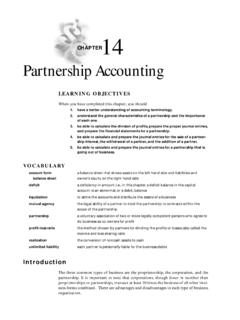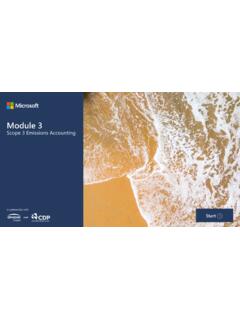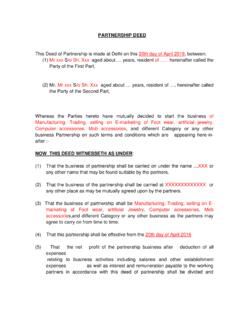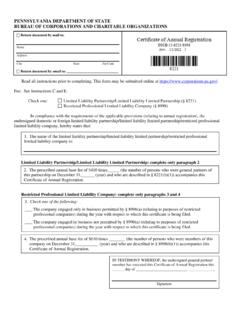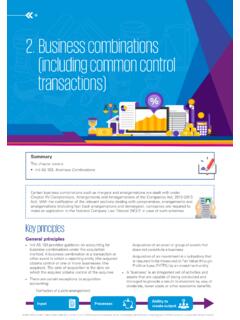Transcription of A Roadmap to Accounting for Equity Method Investments …
1 A Roadmap to Accounting for Equity Method Investments and Joint Ventures2019 The FASB Accounting Standards Codification material is copyrighted by the Financial Accounting Foundation, 401 Merritt 7, PO Box 5116, Norwalk, CT 06856-5116, and is reproduced with publication contains general information only and Deloitte is not, by means of this publication, rendering Accounting , business, financial, investment , legal, tax, or other professional advice or services. This publication is not a substitute for such professional advice or services, nor should it be used as a basis for any decision or action that may affect your business. Before making any decision or taking any action that may affect your business, you should consult a qualified professional advisor. Deloitte shall not be responsible for any loss sustained by any person who relies on this used in this document, Deloitte means Deloitte & Touche LLP, Deloitte Consulting LLP, Deloitte Tax LLP, and Deloitte Financial Advisory Services LLP, which are separate subsidiaries of Deloitte LLP.
2 Please see for a detailed description of our legal structure. Certain services may not be available to attest clients under the rules and regulations of public 2019 Deloitte Development LLC. All rights Publications in Deloitte s Roadmap SeriesBusiness CombinationsBusiness Combinations SEC Reporting ConsiderationsCarve-Out TransactionsConsolidation Identifying a Controlling Financial InterestContracts on an Entity s Own EquityConvertible DebtDisposals of Long-Lived Assets and Discontinued OperationsDistinguishing Liabilities From EquityEarnings per ShareEnvironmental Obligations and Asset Retirement Obligations Equity Method Investees SEC Reporting ConsiderationsForeign Currency Transactions and TranslationsIncome TaxesInitial Public OfferingsLeasesNoncontrolling InterestsNon-GAAP Financial MeasuresRevenue RecognitionSEC Comment Letter Considerations, Including Industry InsightsSegment ReportingShare-Based Payment AwardsStatement of Cash FlowsComplimentary printed copies of Deloitte Roadmaps can be ordered (or preordered) from Deloitte s Roadmap Store.
3 IvAcknowledgmentsThis Roadmap reflects the thoughts and contributions of the consolidation team in Deloitte s National Office as well as the input from the many auditors and advisers in the Deloitte network who, over the past several years, have helped develop the comprehensive views and interpretations in this publication. Rob Moynihan, John Wilde, and Andy Winters led the overall preparation of the 2019 update to this Roadmap , under the guidance of Brandon Coleman. They wish to extend their deepest appreciation to Elena Cilenti, Michael Scheper, and Bailey Walsh for their hard work in updating this publication. Special thanks also go to Teri Asarito, Lynne Campbell, Amy Davidson, Geri Driscoll, David Frangione, Peter McLaughlin, Jeanine Pagliaro, and Yvonne Rudek for their editorial and desktop publishing contributions to this update. vContentsPreface xiContacts xiiChapter 1 Overview 1 Chapter 2 Scope and Scope Exceptions Overview Investments in Partnerships, Unincorporated Joint Ventures.
4 And LLCs Limited Liability Companies LLC That Does Maintain Specific Ownership Accounts LLC That Does Not Maintain Specific Ownership Accounts Limited partnership Interests in Partnerships and Similar Entities General partnership Interests in Partnerships Corporate Joint Ventures Scope Exceptions Investments Accounted for in Accordance With ASC 815-10 Investments in Common Stock Held by a Nonbusiness Entity Investments Held by Real Estate investment Trusts Investments in Common Stock Within the Scope of ASC 810 Investments Held by investment Companies Within the Scope of ASC 946 Investor Is an investment Company Investor Is Not an investment Company Investments in Certain Securitization Entities Applicability of Equity Method to Other Investments Investments Held by Not-for-Profit Entities Equity Method Investments Eligible for Fair Value Option Availability of the Fair Value Option for Financial Instruments With a Substantive Future Services Component Change From the Equity Method to Other Method of Accounting Qualified Affordable Housing Project Investments Before the Adoption of ASU 2014-01 After the Adoption of ASU 2014-01 Proportionate Consolidation Method 17viDeloitte | A Roadmap to Accounting for Equity Method Investments and Joint Ventures (2019)
5 Investments in In-Substance Common Stock Characteristics of In-Substance Common Stock Subordination Risks and Rewards of Ownership Obligation to Transfer Value Initial Determination and Reconsideration Events 25 Chapter 3 Applying the Equity Method of Accounting Overview General Presumption Corporations Limited Liability Companies Partnerships and Unincorporated Joint Ventures General partnership Interest in Partnerships Corporate Joint Ventures Potential Voting Rights Direct and Indirect Interest in an Investee Earnings or Losses of an Investee s Subsidiary Other Indicators of Significant Influence Conditions Indicating Lack of Significant Influence Considerations Related to Certain Investments Investments Held by Real Estate investment Trusts investment in an Entity That Invests in QAHPs Reassessment of the Ability to Exercise Significant Influence SEC Staff s Views on Application of the Equity Method of Accounting 40 Chapter 4 Initial Measurement Overview Initial Measurement Commitments and Guarantees Contribution of Businesses or Assets for an investment in an Equity Method Investee Determining Whether the Counterparty ( Equity Method Investee)
6 Is a Customer Contribution of a Business or Nonprofit Activity [Deleted] Contribution of Financial Assets Contribution of Nonfinancial Assets or In-Substance Nonfinancial Assets That Do Not Constitute a Business or Nonprofit Activity Contributions of Real Estate or Intangibles Transactions Addressed by Other Guidance Contingent Consideration Basis Differences Bargain Purchase Tax Effects of Basis Differences Accumulated Other Comprehensive Income 59viiContents Chapter 5 Subsequent Measurement Equity Method Earnings and Losses Impact of Preferred Dividends on an Investor s Share of Earnings (Losses) Disproportionate Allocation of an Investee s Earnings or Losses in Relation to an Investor s Ownership Interest Hypothetical Liquidation at Book Value Method Capital-Allocation-Based Arrangements Differences Between Investor and Investee Accounting Policies and Principles Equity Method Investee Does Not Follow GAAP Investee Has Elected a Private-Company Alternative Investee Applies Different Accounting Policies Under GAAP Investee Adopts a New Accounting Standard on a Different Date Investee Applies investment Company Accounting Accounting for an Investor s Share of Earnings on a Time Lag Adjustments to Equity Method Earnings and Losses Intra-Entity Profits and Losses Amortization or Accretion of Basis Differences Investee Capital Transactions Other Comprehensive Income Dividends Received From an Investee Interests Held by an Investee
7 Reciprocal Interests Earnings or Losses of an Investee s Subsidiary Contingent Consideration Equity Method Losses That Exceed the Investor s Equity Method investment Carrying Amount Guarantee of an Equity Method Investee s Third-Party Debt Collateral of the Investee Held by the Investor When Equity Losses Exceed the Investor s investment Investee Losses If the Investor Has Other Investments in the Investee Percentage Used to Determine the Amount of Equity Method Losses Additional investment After Suspension of Loss Recognition Stock-Based Compensation Granted by an Investor to Employees of an Equity Method Investee Accounting in the Financial Statements of the Contributing Investor Issuing the Awards Accounting in the Financial Statements of the Investee Receiving the Awards Accounting in the Financial Statements of the Noncontributing Investors Stock-Based Compensation Granted by an Investor to Employees of an Equity Method Investee When the Investee Reimburses the Contributing Investor Costs Incurred on Behalf of an Investee Accounting for Costs Incurred on Behalf of an Investee in the Financial Statements of the Investor Accounting for Costs Incurred on Behalf of an Investee in the Financial Statements of the Investee 131viiiDeloitte | A Roadmap to Accounting for Equity Method Investments and Joint Ventures (2019)
8 Decrease in investment Value and Impairment Identifying Impairments Measuring Impairment Consideration of Basis Differences After Recognizing an Impairment Consideration of Cumulative Translation Adjustment in an Impairment Analysis Consideration of Nonrecourse Debt Impairment of Investee Goodwill Events During a Lag Period Impact on Impairment Evaluation Qualified Affordable Housing Project Investments Change in Level of Ownership or Degree of Influence Increase in Level of Ownership or Degree of Influence Control Initially Obtained ( Equity Method to Consolidation) Increase in Level of Ownership or Degree of Influence Significant Influence Initially Obtained (ASC 321 to Equity Method ) Investee Bankruptcy Increase in Level of Ownership or Degree of Influence Significant Influence Retained Decrease in Level of Ownership or Degree of Influence Significant Influence Retained Decrease in Level of Ownership or Degree of Influence Significant Influence Lost ( Equity Method to ASC 321)
9 OCI Upon Discontinuation of the Equity Method of Accounting Real Estate Investments Sale of an investment in a Real Estate Venture Interest Costs Capitalization of Interest Costs Interest on In-Substance Capital Contributions 154 Chapter 6 Presentation and Disclosure Overview Presentation Balance Sheet SEC Registrants Other Entities Income Statement Tax Effects Disposal Transactions Other Comprehensive Income Cash Flows Earnings per Share Disclosures Equity Method investment Disclosures Other Disclosure Considerations Related-Party Disclosure Requirements Nonmonetary Transaction Disclosure Requirements Discontinued Operation Disclosure Requirements 168ixContents QAHP Investments Presentation and Disclosure Reporting Considerations for Domestic SEC Registrants Measuring Significance investment Test Income Test Asset Test Impact of Retrospective Changes Overview of Rule 3-09 Form and Content Lower-Tier Equity Method Investees ( , Equity Method Investments of an Equity Method Investee) Due Date of Financial Statements for Equity Method Investees Audit Requirements for Financial Statements Overview of Rule 4-08(g) Form and Content Interaction of Rules 4-08(g) and 3-09 Overview of Rule 10-01(b)(1)
10 Form and Content Determining Whether Summarized Interim Information Is Required Filing Status Considerations Considerations for EGCs Considerations for SRCs Considerations for Acquisitions and Dispositions Acquisition of an Equity Method Investee Disposition of an Equity Method Investee Contribution of a Business or Assets to an Equity Method Investee 182 Chapter 7 Identification of a Joint Venture Overview Definition of a Joint Venture Separate Legal Entity Small Group of Entities Mutual Benefit of Members (Venturers) Purpose Management of the Entity Joint Control Variable Interest Entity and Voting Interest Entity Models Decisions Made by Different Governing Parties Unequal Ownership Reassessment of the Joint Venture Determination 194xDeloitte | A Roadmap to Accounting for Equity Method Investments and Joint Ventures (2019)Chapter 8 Accounting by the Joint Venture Overview Initial Contribution of Nonmonetary Assets That Meet the Definition of a Business Impact of Fair-Value-Based Measurement and Pushdown Accounting on Joint Venture Formation Measurement Measurement for Initial Contribution of Nonmonetary Assets That Meet the Definition of a Business Measurement for Initial Contribution of Nonmonetary Assets That Do Not Meet the Definition of a Business Summary of Views for Measurement for Initial Contribution of Nonmonetary Assets That Do Not Meet the Definition of a Business Other Matters Contribution of Nonmonetary Assets After Formation Differences in Accounting Policies Joint Venture s investment in the Stock of a Venturer Start-Up Costs Incurred by the Joint Venture 203 Chapter 9 Accounting by the Venturer Init










